Capsicum
Capsicum is one of the most popular vegetable grown in India. Vernacular name of Capsicum are- Bell Pepper, Sweet Pepper, Shimla Mirch in India. It is rich in many nutritive elements such as Vitamin A, Vitamin C and minerals like Calcium, Magnesium, Phosphorous , Potassium etc.
It is a cool season crop but can be grown throughout the year under protected conditions. It is a perennial herbaceous plant belongs to solanceace family. It attains maximum height of 75cm. It has small white or purple color flowers which bears fruits.
Season:
Growing season of Capsicum depends upon region and climate. Capsicum can be grown as follows-
- Winter Season- Capsicum is typically grown from October-February in regions with mild winters, such as central and North India.
- Summer Season- In southern and coastal areas of India, Capsicum can be grown during the month of March-July or August.
States:
Major Capsicum growing states are Maharashtra, Gujarat, Andhra Pradesh, West Bengal, Haryana, Uttar Pradesh, and Punjab, Assam. West Bengal is the leading producer of Capsicum.
Capsicum requires average temperature of 20-25oC for its cultivation. Sowing temperature of 12-15oC and Harvesting temperature of 30-35oC with average rainfall of 600-1500mm is required.
Capsicum can be grown in wide range of soil, but clay and loamy soil is most preferable for its cultivation. It can withstand acidic soil to some extent. Ideal pH range for capsicum cultivation is 5-6.
Seed Rate-
200-300gm/acre seeds are enough.
Seed Treatment-
Treat the seeds with Thiram , Captan @2gm/kg of seeds 24 hours before sowing.
Spacing-
Use Row to Row spacing of 50 cm and Plant to Plant spacing of 40 cm
Sowing Depth-
Seed should be sown at the depth of 2-3cm.
For capsicum cultivation, field should be well prepared. To bring the soil to fine tilth, 5-6 ploughing followed by Planking is enough. Well decomposed farm yard manure should be incorporated into the soil @20-25tonnes/acre.
Nursery Management and Transplanting-
Seeds beds of 300*60*15cm are prepared to raise seedlings. Seeds are sown in raised nursery beds and after sowing cover the nursery beds with thin layer of soil. Light irrigation should be given immediately after sowing for optimum germination of seeds.
Transplanting is done when seedlings attain 4-5 true leaves. Seedlings of 30-35 days are used for transplanting. Transplanting is mainly done in evening during cloudy weather. Apply water to the transplanted seedlings so that seedlings can be easily uprooted.
Light irrigation is given immediately after sowing the seeds. Then next irrigation is given after transplanting and then later irrigation is given when requires. Irrigation should be given at regular interval but not waterlogged.
Stages of Irrigation-
- Seedling Stage
- Vegetative Stage
- Fruiting Stage
Drip irrigation and sprinkler irrigation are commonly used method of irrigation in Capsicum.
At the time of Land preparation, 20-25tonnes/acre of well decomposed far, yard manure should be incorporated to soil. Along with Farm yard manure, fertilizer such as Nitrogen @50kg/acre in the form of urea @100kg/acre, Phosphrous @25kg/acre in the form of Super Phosphate @175kg/acre and potassium @12kg/acre in the form of Muriate of Potash @20kg/acre.
Full dose of Nitrogen, Phosphorus and 1/3rd dose of Nitrogen is mixed in rows just before transplanting and rest of the nitrogen is given in split doses one after one month of transplanting and second after second month of transplanting.
For a good yield of crop, weed control is crucial. Weeding should be done at regular intervals. Earthing up after 2-3 weeks of transplanting should be done to control weeds. First weeding is done after 30 days of transplanting and second weeding is done after 60 days of transplanting.
If weed infestation is higher, herbicide can be used to suppress the growth of weeds. For pre-emergence herbicide- Metachlor is effective against broad leaf weeds. It should be used @800ml/acre before emergence of weeds. For post-emergent herbicide- Glyphosate can be used @500ml/acre.
- Nitrogen-
Symptoms-
Yellowing of leaves and premature death of foliage. Leaves are small and turn yellow-green throughout. Gradual drying beginning at leaf margins, Plants develop few flowers and fruit setting is poor.
Management-
Apply Nitrogen containing fertilizer such as urea, ammonium sulfate, calcium nitrate. Planting nitrogen fixing cover crops or using green manure can overcome nitrogen deficiency in capsicum.
- Phosphorus-
Symptoms-
Phosphorus deficient plants show retarded growth. Leaves are hard and brittle to touch. Fruit is underdeveloped. Root system is also undeveloped. Older leaves show wilting symptoms.
Management-
- Phosphorus rich fertilizer such as Superphosphate.
- Avoid Excessive fertilization
- Ensure proper irrigation practices to maintain soil moisture level conducive to nutrient uptake.
- Avoid overwatering that can leads to leaching of nutrients.
- Potassium-
Symptoms-
Brown spots at the edges of fruits and leaves and sometime there is curling and drying of leaves. There is little or no fruit setting and are smaller than usual.
Management-
Foliar spray of K2SO4 1% Fortnightly intervals.
- Copper-
Symptoms-
Leaf margins curl up and dry. Leaves and fruits become narrow & rectangular in shape. Yellowing of young leaves. Copper deficiency leads to abnormal or misshapen fruit growth.
Management-
- Foliar application of CuSO4 @2%
- Zinc-
Symptoms-
Leaves become small and chlorosis. Discoloration between the veins. Plants size is small than usual and growth is stunted.
Management-
- Foliar spray of ZnSO4 @0.5%
- Apply organic manure before seeding or transplanting.
- Do not over fertilse with Phosphorus.
- Sulphur-
Symptoms-
Sulphur deficiency leads to yellowing of leaves. Yellowing is apparent in intervenial veins while veins remain green. Oldest are affected first by sulphur deficiency.
Management-
Apply Gypsum, ammonium sulfate, and elemental sulfur to the crops to overcome sulfur deficiency.
- Molybdenum-
Symptoms-
The symptoms can be seen on foliage, foliage turns yellow-green and growth is also restricted. Stunted growth. Affected leaves shows marginal necrosis and brown spots. Leaves may show abnormal curling and twisting.
Management-
Application of Molybdenum containing fertilizers such as Sodium Molybdate or Ammonium Molybdate can help overcome deficiency.
- Manganese-
Symptoms-
Chlorotic spots on the upper leaves while the lower leaves curls upwards. Growth is stunted. Leaves become yellow from bottom to top. As the deficiency progresses, the area between the veins become paler and plant dry and die up.
Management-
Apply fertilisers containing manganese such as manganese sulfate or chelates.
- Magnesium-
Symptoms-
Light green marginal chlorosis is visible in leaves. Symptoms start on young leaves later spreading to older leaves also. Necrotic patches develop within the chlorotic areas.
Management-
Foliar application of MgSO4 @1% fortnightly intervals.
- Iron-
Symptoms-
Deficiency symptoms shown at the later stages of growth. Young leaves fade and then become yellow in the areas between the veins while veins remain green. Younger leaves may appear white due to severe chlorosis. In Severe cases, leaves drop prematurely.
Management-
- Adjust Soil pH, if the pH of soil is above 7.0 lower it to the optimal range to capsicum using elemental sulfur or acidifying fertilizers. This improves iron availability.
- Apply Iron chelates.
- Calcium-
Symptoms-
Calcium deficiency leads to Blossom End Rot disorder in Capsicum. This condition affects immature peppers. Bottom of the fruits develop pale green or sunken areas. The pale sunken area blacken over the time. Several parts of the fruits may also affected.
Management-
Apply Calcium Nitrate. Start adding calcium to the plants when plant is blossoming and continue till fruit setting. Don’t over irrigate the plants.
- Blossom End Rot-
Caused by- Calcium Deficiency
Symptoms-
Symptoms appear on the fruits as soft spots on fruits which develop into sunken dark-tan lesions. Affected fruits are unmarketable. The spots enlarge as the fruits grow and they may cover half of the fruit surface. The tissue dries out and becomes papery and straw colored. Fruits ripen earlier as compare to healthy one.
Management-
- Manage proper irrigation.
- Avoid excessive application of Nitrogenous fertilizer.
- Weekly foliar application of Calcium nitrate can overcome calcium deficiency.
- Sunscald-
Caused by- Caused due to excessive exposure to sunlight
Symptoms-
Symptoms of sunscald are somewhat similar to Blossom End Rot. Soft, tan colored sunken lesions appear on that side of fruits which is mostly exposed to sunlight. Affected areas appear as pale, bleached and white due to excessive exposure to sunlight. The damaged areas may become dry and will feel like sunburn. Browning on the surface of the leaves.
Management-
- Provide shade to the plants area.
- Increase foliage density.
- Apply a layer of mulch to avoid plants to expose to sunlight
- Water regularly especially during the dry days
- Fruit Cracks-
Caused by- Fruit cracking is caused due to rainy and high humidity environment.
Symptoms-
Very fine superficial cracks appears on the surface of fruits that gives rough texture to the fruits. Cracks often appear on the stem end of the fruit but mainly appears on the shoulder of the fruits.
Management-
- Don’t over water or over fertilize the plants.
- Prune excess foliage to reduce competition among fruits and leaves for nutrients and water.
- Plant resistant cultivars
- Aphids-
Stage of attack- Attacks on all stages
Symptoms-
- Nymph and adults suck the sap from the leaves
- Causing discoloration of leaves such as yellowing.
- Also causes wilting and distortion and fruit abortion
- Aphids generally appear on the underside of the leaf, they excrete honeydew like substance, which draws ants and sooty mold, turning the leaves to black and lowers the photosynthetic activity.
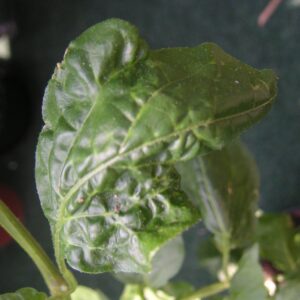
Management-
- Collect and destroy all the infected plants from the field
- Use sticky traps
- Remove weeds from the field
- Release natural enemies in the field to control aphids such as Ladybug, lacewings, parasitic wasp.
- Apply Neem oil @5ml/L of water
- Foliar application of Imdiacloprid @2ml/L of water
- Beet Armyworm-
Stage of attack- Larvae stage
Symptoms-
- Beet armyworms damages leaves and fruit. The larvae which are small green caterpillar, feed on the plant tissue.
- Leaves show irregular holes leaving only the veins intact.
- Small holes or larger areas of damage can be seen on the surface of the fruit.
- In severe cases, beet armyworms can defoliate the plant, leading to stunted growth of the plant.
Management-
- Introduce natural enemies to the field such as wasps to control beet armyworm population.
- Seed treatment with Thiamethoxam @4gm/kg of seeds before sowing
- Rotate with non-host crops
- Remove and destroy the infected plants from the field.
- Flea Beetles-
Stage of attack- Larval stage
Symptoms-
- Flea beetles are small beetles that can cause significant damage to the crop. Damaging symptoms include tiny holes in shoot
- Plants may exhibit stunted growth symptoms
- Affected leaves show sign of yellowing or browning around the holes.
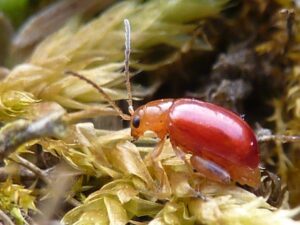
Management-
- Control the alternate weed host
- Remove and destroy all the infected plants from the field and maintain field sanitation.
- Set up yellow sticky trap
- Application of Carbaryl and Malathion 50%EC @3gm/L of water and 7ml/L of water respectively.
- Leaf Miners-
Stage of attack- Larval Stage
Symptoms-
- Leaf miners burrow into the leaves of capsicum plant
- Leaves show winding, white or translucent trails or tunnels.
- Irregular discolored patches appear on the leaves
- Affected leaves might curl or become distorted due to the internal damage caused by the larvae.
- Severely infected leaves may drop prematurely
- Leaves become thin and brittle over time, makes them susceptible to tearing and other damage.
- Overall plant growth may be stunted as the plant diverts energy to deal with the damaged caused by the miners.
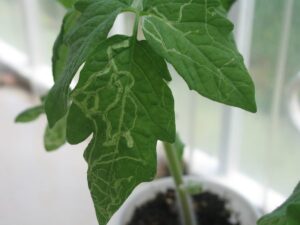
Management-
- Apply following insecticide to control leaf miners-
Quinalphos 25% EC @2ml/L of water
Imdiacloprid 17.8%SL @0.5ml/L of water
- Whitefly-
Stage of attack-Larval stage
Symptoms-
- Yellowing of leaves
- Infested leaves shows curling symptoms
- Plants may exhibit reduced growth and vigor due to the stress caused by feeding whiteflies.
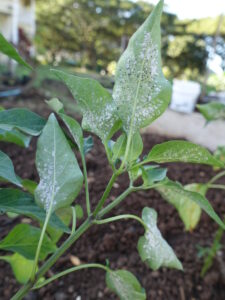
Management-
- Treat seeds with Imdiacloprid @4gm/kg of seeds before sowing or transplanting.
- Rotate crops with non-host crops
- Collect and destroy all the infected plants from the field to maintain field sanitation.
- Place yellow sticky trap to trap whiteflies
- Use Neem based insecticide
- Tobacco Mosaic Virus-
Causal Organism- Tobacco Mosaic Virus
Symptoms-
- Leaves shows light and dark green or yellow patches.
- Leaves shows curling symptoms or sometime become deformed.
- Affected plants also shows stunted growth
- Irregular spots on leaves
- Dark, dead patches might develop on leaves and stems.
Favorable Conditions-
Temperature of 20-30oC, dry climates favors the growth of TMV.
Management-
- Use disease resistant varieties.
- Sanitize tools and equipment before using them
- Practice crop rotation.
- Remove and destroy the infected plants and maintain field sanitation.
- Using Neem oil can somehow control the virus but not completely.
- Cucumber Mosaic-
Causal Organism- Cucumber Mosaic Virus
Symptoms-
- Leaves display patchy, mosaic like pattern with varying shades of green and yellow.
- Leaves become wrinkled, crinkled or develop unusual shapes, showing significant deformation.
- Fruits becomes misshapen and malformation
- Small, dead, brown necrotic patches develop on leaves.
- Flowers may drop prematurely.
Favorable Conditions-
Warm temperature, High Humidity favors the growth of virus.
Management-
- Use disease resistant cultivars.
- Use of insecticide to control aphid population that are vectors of Cucumber Mosaic Virus Neem oil, Imdiacloprid 17.8% @2ml/L of water.
- Powdery Mildew-
Causal Organism- Leveillula taurica
Symptoms-
- White powdery growth or grayish fungal growth can be seen on the leaves.
- Infected leaves shows curling symptoms
- Yellowing of leaves
- Plants may also show stunted symptoms
- Premature dropping of leaves
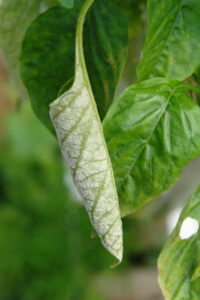
Favorable Conditions-
Moderate temperature of 20-25oC, High humidity, Overhead irrigation favors the growth of fungus.
Management-
- Remove all the infected plants from the field and maintain field sanitation.
- Avoid overhead irrigation instead use drip irrigation
- Use sulfur based fungicide or Copper based fungicide
- Anthracnose-
Causal Organism- Colletotrichum spp
Symptoms-
- Dark sunken lesions on fruits sometime surrounded by water soaked areas.
- Leaves may develop small, irregularly shaped spots that expand over time.
- In severe conditions, defoliation can also occur
Favorable Conditions-
Temperature range of upto 28oC and relative humidity upto 95% favors the growth of fungus.
Management-
- Practice crop rotation to break the disease cycle of fungus
- Maintain field sanitation
- Maintain proper spacing to improve air circulation and reduce humidity.
- Plant disease resistant varieties
- Avoid Overhead irrigation
- Application of Propiconazole 25 EC @200gm/acre
- Leaf Curl Virus-
Causal Organism- Begomovirus
Symptoms-
- Leaves curl upwards or downwards, often become brittle.
- Yellowing of leaves, usually starts from the margins
- Plants may show stunted growth
- Fruits may become distorted or show abnormal growth patterns
Favorable Conditions-
Warm Temperature of upto 25-30oC, humidity above 80% favors the growth of this virus
Management-
- Use disease resistant varieties
- Maintain field sanitation by destroying the infected plants from the field.
- Rotate the crops with non –host
- Apply Carbofuran 3G @3-4kg/acre
- Foliar application of Dimethoate @2ml/L of water
Harvesting-
Capsicum should be harvested when they reached the maturity stage. When the fruits are firm, glossy and reach to their maximum size then we can harvest the crop. Harvesting should ideally be done in the cooler parts of the day. Such as early morning or late evening to minimize stress on the plants and maintain fruit quality.
Use sharp, clean scissors or pruning shears to cut the fruit from the plant. Avoid pulling or twisting of the fruits, which can damage the plant and reduce future yield.
Yield-
The average yield of capsicum is upto 40-60tonn/acre